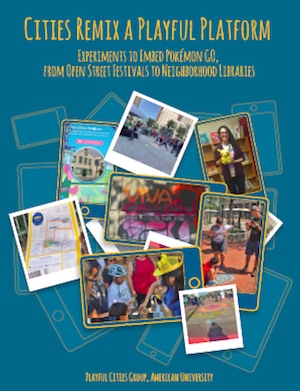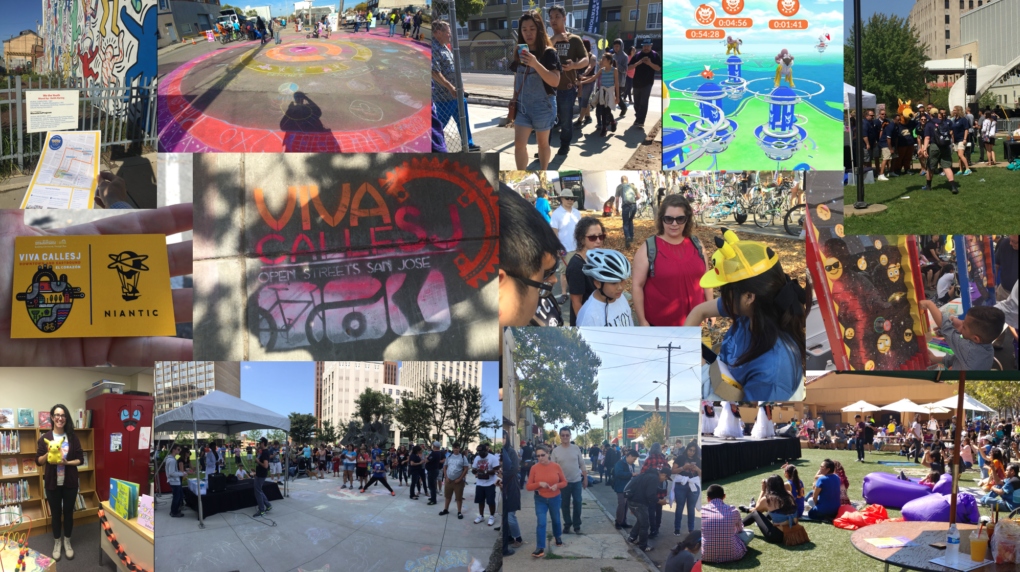OVERVIEW: This is the first major report showing how cities can align major augmented reality (AR) platforms with local and community goals. Based on research in five cities, we published a report: “Cities Remix a Playful Platform” that shows how cities must be proactive to align games with their own campaigns and events — from walking tours at neighborhood libraries to Open Street Festivals.
Key findings are below…
>> Download or cite the final report by American University scholars Benjamin Stokes, Aubrey Hill and Samantha Dols. Funding for the report comes from the John S. and James L. Knight Foundation and Niantic Inc. Published by the AU Game Lab with the Center for Media and Social Impact.
Highlights
 The report is the first major study to show how cities can harness the popularity of commercial games to draw attention to local areas and shape engagement in existing events.
The report is the first major study to show how cities can harness the popularity of commercial games to draw attention to local areas and shape engagement in existing events.
One finding is that cities can stimulate their economies with AR platforms (Augmented Reality) tied to fan culture. For example, the report profiles San Jose, where officials engaged 35,000 Pokémon GO players in their open street festival. Players released more than $450,000 into the local economy, while celebrating local streets filled with biking, walking and play.
Cities can also engage residents with history in physical space, as in Philadelphia, where neighborhood libraries used Pokémon GO to guide walking tours of famous murals, landmarks and points of pride.
City experiments include:
- Open Street events in San Jose; CA, in Charlotte, NC; and in Philadelphia, PA
- Library-based walking tours based in five branches of the Free Library of Philadelphia
- Sharing power to negotiate the data layer in Boston, MA
- …and more, from New Bedford, MA, to Chester, UK, and Akron, OH
These experiments were often supported through a multi-year partnership between Pokémon GO creator, Niantic, Inc., and the John S. and James L. Knight Foundation, which invests in informed and engaged communities.
Strategies for cities
For cities considering augmented reality, our research highlights five opportunities:
- Adapt games for local events. Cities can adapt AR platforms to amplify local strengths and better reflect civic needs. In particular, cities can layer walking tours, scavenger hunts, and other activities on top of the game — adding value for existing players and integrating play with local campaigns.
- Invite player networks (not just individuals). Pokémon GO players often arrived in groups, including across generations and with social media networks poised for discussion. Recruiting is also easier through player and fan networks, and cities can help by tapping network leaders, beyond the usual open invitations.
- Focus digital activity near inviting and accessible physical spaces. Players often want to interact, but social mixing can happen more easily when cities position play near the right physical spaces with seating and food.
- Bring local culture to online platforms. Players can connect to global cultures through AR platforms, including the Pokémon universe. At the same time, games can engage players with local culture, from murals to local history. In a digital age, cities should increasingly invest in the technology innovations that shape how we discover local culture.
Discussion probes
Our findings point to the future of cities. Public space is increasingly hybrid, with a data layer that can be playfully engaged — including to build community. Players come not just as individuals, but with networks to global culture, local ties and self-organizing groups.
To facilitate discussion around the report, we have posted a few probes:
- Social Mixing through AR
- Open Streets Festivals with Pokémon GO
- Physical Interventions to Remix the Game
…more to come, see our updates…
Methods
The analysis by American University is based on usage statistics from city events, surveys of players, and extensive interviews with city leaders.
Beginning in mid-2017, our researchers traveled to directly observe many of the city events in person. Online observations were just as important, including in player forums used for planning group attendance at live events and chat during the event (especially in Discord channels, where players were very welcoming). Researchers gathered hundreds of player surveys at the large events in San Jose and Philadelphia, and compared their quantitative data with third-party evaluations (most notably the Mineta Transportation Institute report, which included 800+ respondents that compared non-players and players). Across the six months of data collection, interviews with program staff and partners were particularly important, since the researcher’s primary emphasis was on how cities positioned and remixed the game to advance their goals; these ranged from the Niantic CEO and Vice Presidents at the Knight Foundation, to local staff and the businesses and organizations that partnered in each city.
Acknowledgements
Thank you, in particular, to Yennie Fuller, Lilian Coral, Sam Gill, Vikram Grover and Lucas Hernandez; this report only happened because of the doors they opened and the collaborative spirit they maintained. We are also hugely indebted to the many interviewees who gave us their time, in hopes that this report could help other cities in the future. Special thanks are due to our player informants, who generously introduced us to their teams and networks to show how they coordinate in play and socializing, and how their passions for the game align with their activities in cities.
About the authors
Benjamin Stokes is an Assistant Professor at American University in the AU Game Lab, and is a co-founder of Games for Change; Samantha Dols is a PhD candidate at American University in the School of Communication, and is the Founder of the World Lens Foundation; Aubrey Hill is a community game designer and organizer with an MA in Game Design from American University.

Funding for the report and this website comes from the John S. and James L. Knight Foundation and Niantic Inc, via the Miami Foundation.
>> To cite the report, see our download page.
